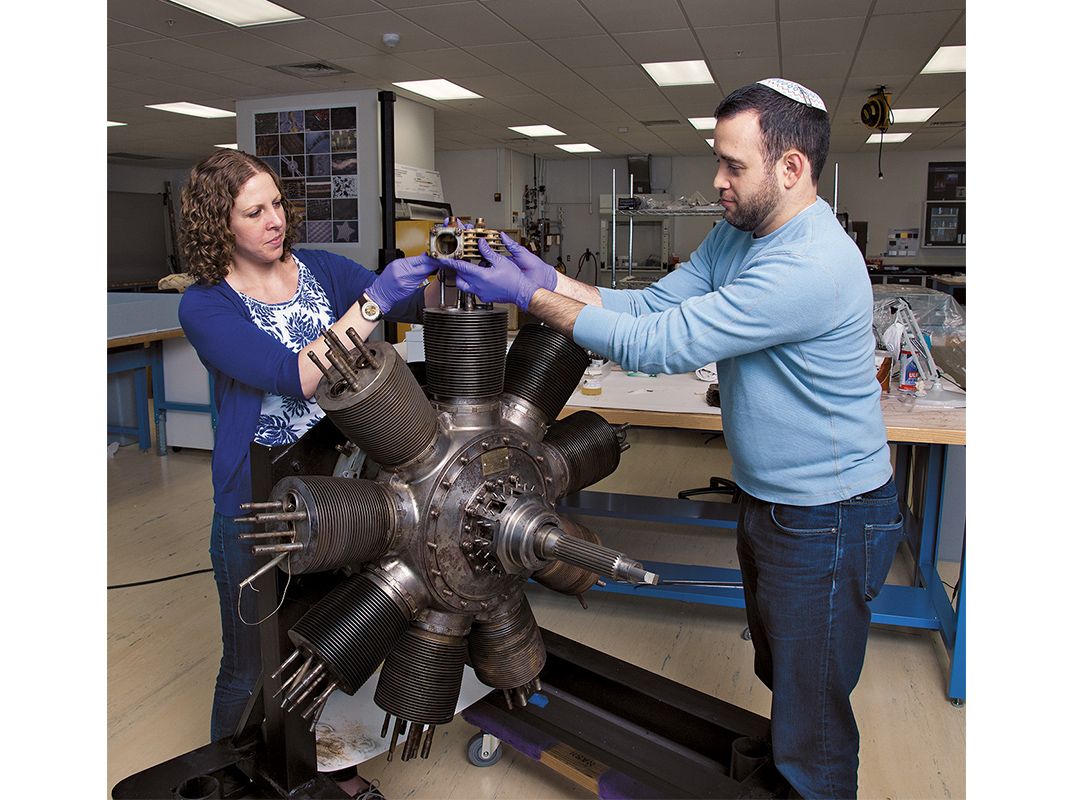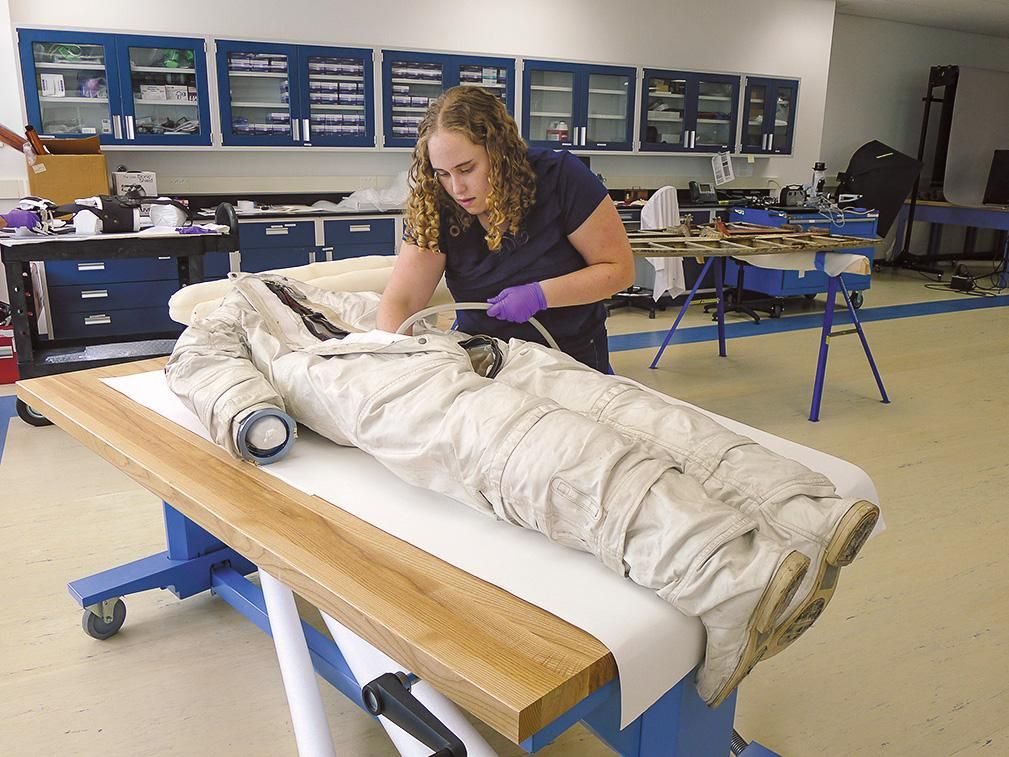When the Patient Is an Engine
/https://tf-cmsv2-smithsonianmag-media.s3.amazonaws.com/filer/3d/6a/3d6ac98a-7bdc-4ef1-a27e-5a4c428b9f16/16e_on2016_a19710896000_dt_05042016_live.jpg)
A casual observer might have mistaken it for a torn, rolled-up window shade. But it’s a precious, historic piece of fabric, taken from the fuselage of a Salmson 2.A.2 of the 1st Aero Squadron, piloted by Lieutenant Blair Thaw over France during World War I.
“The fabric had been doped,” says Steven Pickman, a contract conservator at the National Air and Space Museum. “Cellulose nitrate, or dope, is used as a tautening agent, and it’s what allows the fabric to be drum-tight on the surface of an airplane’s frame. Unfortunately, it continues to tighten over time, and will literally tear itself apart.”
But Pickman, along with the Museum’s chief conservator, Malcolm Collum, came up with a plan to relax the material, and the fabric has now been cleaned and mounted on a wooden strainer so that curators and researchers can examine it more closely.
That’s just one item—out of more than 600—that the conservation department’s Triage Team has addressed over the past three years. Just as medical triage sets priorities for injured people, conservation triage analyzes the risk posed to an object if immediate action isn’t taken.
The team gets financial support from the Collections Care and Preservation Fund project, which supports conservation efforts large and small, says William Tompkins, director of the Smithsonian Institution’s National Collections Program. The fund has awarded grants to preserve a single item (Thomas Jefferson’s Bible, for example) or hundreds of artifacts (upgrading specimen storage at the National Museum of Natural History). In the past 10 years, says Tompkins, the Fund has distributed $38.8 million in grants to preserve items throughout the Smithsonian Institution.
At the Museum, the money is used to survey items that are scheduled to move from the Paul E. Garber restoration facility in Maryland to the Steven F. Udvar-Hazy Center in Virginia. Once an artifact is earmarked to be moved, a staff member examines it for chemical or structural deterioration. If any is found, the object ends up in the lab where conservators Pickman and Rachel Greenberg work.
Chemical deterioration “includes things like heavy metal corrosion, such as cadmium and lead,” explains Greenberg. Pickman adds: “If there’s a ferrous nut, bolt, or screw and it’s aerospace- or aviation-related, chances are it probably has cadmium plating on it.”
The plating is fine while intact, but when it begins to deteriorate, it becomes a hazard for the staff. That’s when the Triage Team steps in to stabilize the artifact so that it’s safe for handling.
Pickman and Greenberg were both trained as object conservators; after a year of working together, the two often finish each other’s sentences.
“We work with a lot of plastics, which are found on certain types of instruments,” says Pickman. “Guides for pilots…”
“…and plotting boards and early flight computers,” finishes Greenberg.
This year the Triage Team has treated a lot of cockpit instruments—in particular, dials and gauges. But they’ve also worked on a spacesuit, returned after 20 years on loan (before it could go into storage, it required structural support so it wouldn’t become deformed), and tiny objects, including airline company pins and employee buttons.
They have a lot of unpronounceable technology at their disposal: X-ray fluorescence spectroscopy (to identify the elemental composition of unknown materials, which can confirm the presence of hazardous materials), optical and digital microscopy (to examine the artifacts), and Fourier transform infrared spectroscopy (to identify organic compounds), just to name a few.
Right now they’re working on a Clerget 9A radial diesel engine, the model that would become the first diesel aircraft engine to fly in France (in a Morane 135 in 1929). The engine had two major issues: corrosion inside and out and a coating on the outside that, beginning to degrade, had to be removed.
Normally, the team wouldn’t take apart the engine; they’d leave that to the restoration department. But after a borescope revealed a fair amount of corrosion inside the engine, Pickman and Greenberg decided to take the plunge.
“Since the two of us are not engine specialists,” says Greenberg, “we’ve done a fair amount of collaboration with the restoration shop. They’ve been helping us to understand the different parts of the engines, and how to take things apart correctly.”
One challenge they immediately faced was a lack of diagrams or schematics for the Clerget, which is a fairly rare engine. They’ll do a lot of documentation—photographic and written—not only to determine treatment, but also to understand the artifact’s history.
“Documentation wasn’t as important in the past,” says Greenberg. “We’re trying to find out what’s been done to an object so that curators will have that information in the future.”
Out of the 200 artifacts the two have surveyed this year, they agree on a favorite: a Wright XR-2120, radial 12 engine. The 1933 engine is partially cut away to reveal its interior elements. The Wright engine was slathered with a brown preservative coating meant to inhibit corrosion. But the coating was so thick it was slumping off and pooling in areas. Once the material becomes tacky, dust, insects, and debris can become embedded in it, which leads to—you guessed it—corrosion.
“It’s kind of amazing when you start peeling away that coating,” says Pickman. “We found the medallion from the engine maker. And we could see the vivid colors of the enamels and glass. We could also easily see modifications and repairs made to the engine, something in which the curator is intensely interested.”
You could say that it’s not just the artifacts that are affected by going through triage; the conservators are transformed as well. Pickman, who started his career caring for archaeological and ethnographic objects, is now mesmerized by engines: “I love planetary gearing now. I know it’s not for everybody, but there’s something absolutely gorgeous there.”



